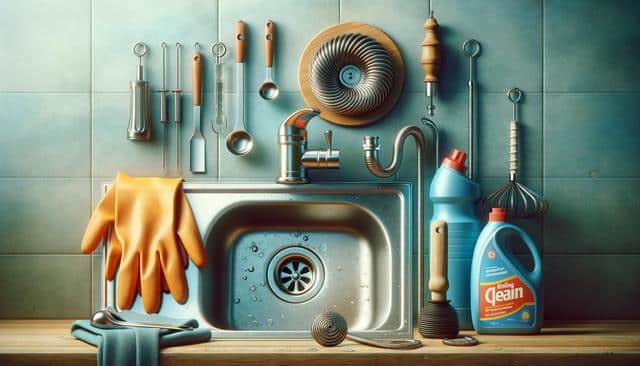Effective Kitchen Drain Cleaning Options for a Clearer Sink
A kitchen drain helps move waste water out. Keep it clean to avoid clogs. Use filters or strainers to stop food bits from getting stuck. With care, your drain will work well and keep your sink clear

Understanding the Common Causes of Kitchen Drain Clogs
Kitchen drains face a lot of wear and tear from daily use. Most clogs are caused by a buildup of grease, food particles, soap scum, and other debris. These materials can stick to the inner walls of pipes over time, gradually reducing water flow and eventually causing a blockage. Knowing what causes the problem is the first step to choosing the right cleaning method. Common culprits include:
- Cooking grease and oils poured down the sink
- Food scraps not caught by a strainer
- Soap and detergent residue
- Hard water minerals forming deposits
Understanding these causes can help you develop better daily habits, such as scraping plates into the trash before rinsing and avoiding the disposal of grease in the sink. Prevention plays a key role in reducing the need for frequent deep cleaning and can extend the life of your plumbing system.
DIY Drain Cleaning Methods for Routine Maintenance
Regular maintenance can keep your kitchen drain functioning properly without the need for professional help. Several do-it-yourself (DIY) methods are simple, affordable, and effective. For example, a mixture of baking soda and vinegar is a well-known natural cleaning solution. Here’s how to use it:
- Pour 1/2 cup of baking soda down the drain
- Follow with 1/2 cup of white vinegar
- Let the mixture sit for 15-30 minutes
- Flush with hot water to clear the pipe
Another common method is using boiling water alone to help break down grease and flush out minor blockages. It’s safe for most types of kitchen plumbing and can be done weekly as a preventive measure. A plunger can also be useful for dislodging clogs close to the drain opening. These methods are ideal for light maintenance and early-stage clogs.
Manual Tools and Equipment for Deeper Cleaning
When DIY mixtures aren’t enough, manual tools can provide more effective cleaning power. One popular tool is a drain snake, also known as a plumber’s auger. It is a flexible, coiled wire that can be inserted into the drain to manually break up or retrieve clogs. Another option is a drain cleaning brush, which works well for clearing buildup near the drain opening.
For those who want to avoid dealing with the mess, there are mechanical drain augers that operate with a crank or motor, offering more strength and ease of use. These tools are particularly useful for:
- Removing hair and food waste deep in the pipe
- Breaking through stubborn grease layers
- Clearing partially blocked garbage disposal units
Always follow safety instructions when using these tools, and consider wearing gloves and protective eyewear during the process. While effective, these methods should be used carefully to avoid damaging your plumbing system.
Chemical Drain Cleaners: When and How to Use Them
Chemical drain cleaners are another option, often used as a last resort for tough clogs. These products are designed to dissolve grease, hair, and other organic materials. They come in liquid, gel, or powder form and typically require pouring directly into the drain, followed by a waiting period and flushing with water.
While convenient, chemical cleaners should be used with caution. Overuse can corrode metal pipes or damage older plumbing systems. It’s important to read the label and follow all instructions, including ventilation and protective measures. These products can be helpful for:
- Breaking down difficult clogs in inaccessible areas
- Maintaining free-flowing pipes when used occasionally
- Quick fixes before a deeper cleaning session
They should not be the first choice for regular maintenance and are not recommended for households with septic systems, as they can disrupt bacterial balance. Always store them safely away from children and pets.
Professional Services for Long-Term Drain Health
Sometimes, even the most well-maintained drains need professional attention. If you’ve tried multiple cleaning methods without success, or if you’re dealing with recurring clogs, it might be time to call a plumber. Professionals have access to high-grade tools like hydro jetters, which use high-pressure water to clean pipes thoroughly.
Hiring a professional can also help identify underlying issues such as:
- Pipe damage or corrosion
- Tree root intrusion
- Improper pipe slope or installation
These issues can’t be resolved with chemical cleaners or DIY tools alone. A plumber can perform video inspections to locate the exact source of the problem and recommend the most effective solution. While this option is usually more expensive, it ensures a long-lasting fix and prevents further damage to your plumbing system.
Conclusion: Choosing the Right Kitchen Drain Cleaning Option
Maintaining a clean kitchen drain is crucial for avoiding costly repairs and keeping your sink functioning efficiently. From simple home remedies to professional services, there are multiple drain cleaning options to suit different needs and budgets. Start with regular maintenance to prevent buildup, and escalate to tools or professional help as necessary. Choosing the right approach not only keeps your kitchen clean but also supports the long-term health of your plumbing system.